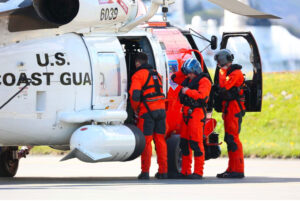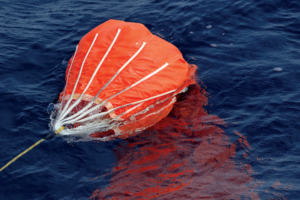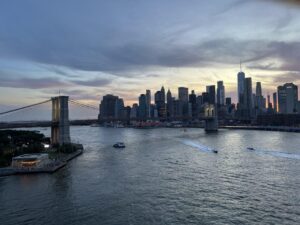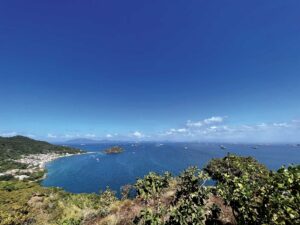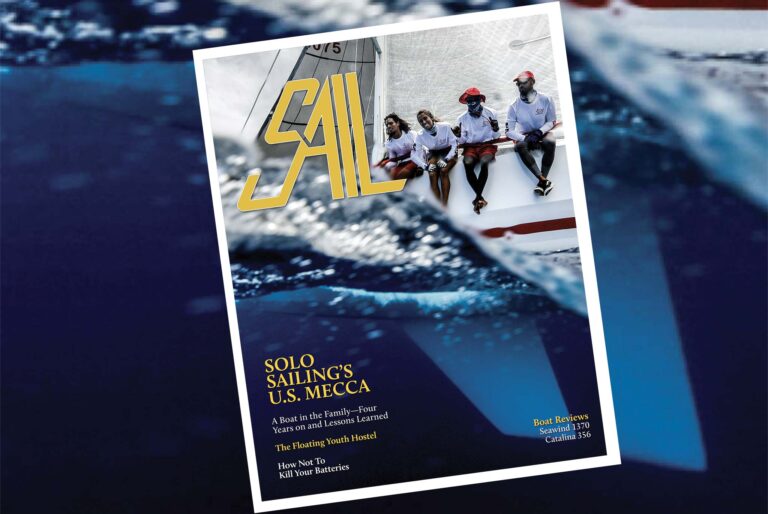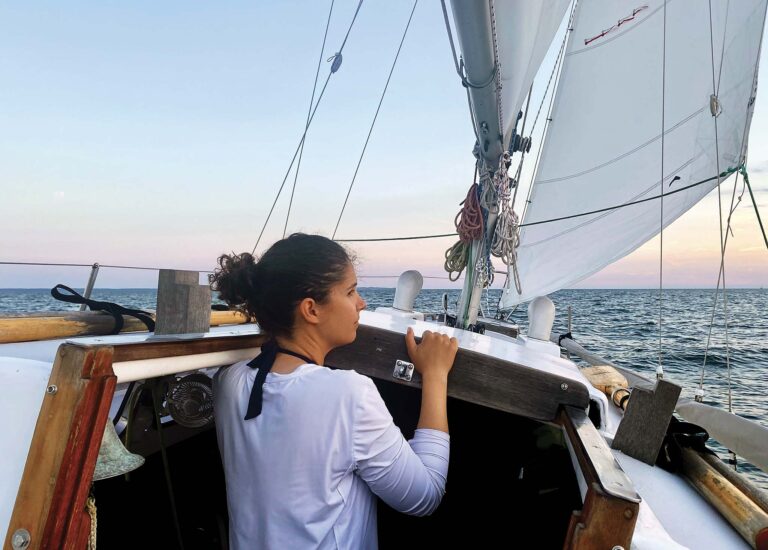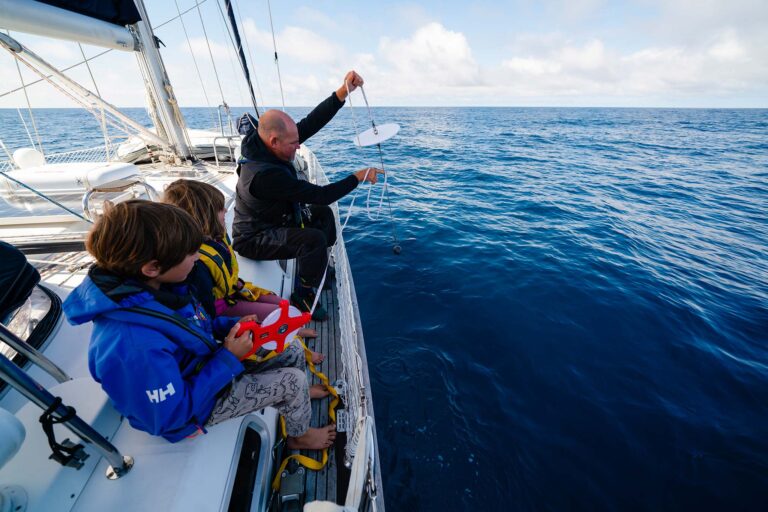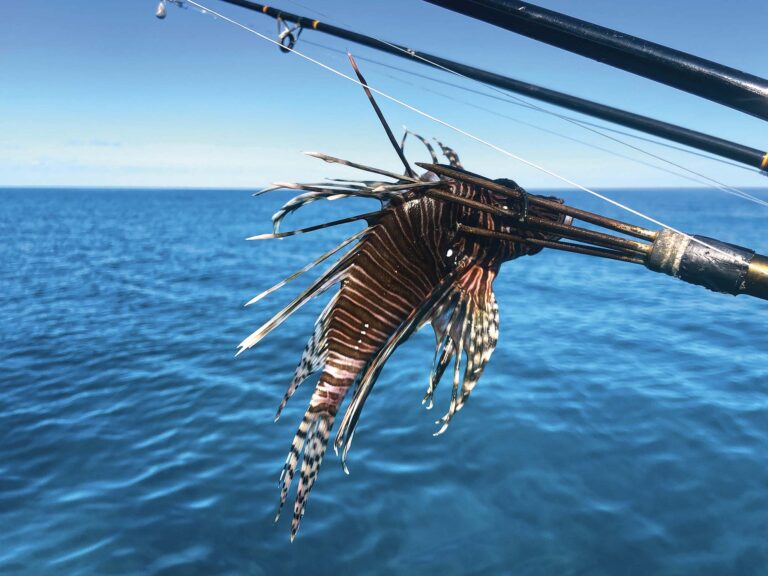It is the third day of our seven-day cruise aboard our 18ft Herreshoff Catboat. I wake at dawn to the gentle rocking of the boat in Oak Bluffs Harbor. Tiny waves lap against the hull. All is peaceful until I stretch my legs and kick a bag full of clothing. Slowly, I uncramp my aching body and sit up, only to hit my head on the overhead. My knees are up to my chin because my feet lie on another bag, this one full of supplies. Suddenly, I am hysterical with laughter.
My husband, Jay, is lying across from me on the other bunk. The centerboard trunk is between us. I can only guess what he might be feeling, given his 6ft frame.
“This is crazy,” I say, but Jay can’t understand me because I am laughing so hard. I spread my arms out and say, “Look at this!
We’re crazy! The whole thing is silly!”
He still can’t understand what I’m saying, but he gets my meaning. I can tell by his smile.
“And whose idea was this?” he reminds me.
I smile back at him, sheepishly.
It is true. This was my idea. Through many summers on Martha’s Vineyard, Jay and I had daysailed in and around Katama Bay and Edgartown Harbor on our catboat SkipJack. Once in a while we would even go as far as Cape Poge Pond. But I had never sailed up or down to the outskirts of the island. Nor had I ever used our catboat to explore the area’s various harbors, lakes and coves. As we sailed into Oak Bluffs, I was enchanted by the sparkling water, hosting all types of craft, set against a backdrop of cottages. The sky was a brilliant blue. The carefree energy of the community was palpable.
I have spent many days in Oak Bluffs, sitting on the docks, looking out over the water at the boats bobbing in the harbor, but this was an entirely different experience. I remembered a catboat I’d seen docked along Beach Road. On each side of its bow were painted cat eyes. It was then that it occurred to me: “I wonder what it would be like to see the island through the eyes of a catboat?” Thus was our journey born.
There are several different types of catboat. Ours is a Herreshoff America, built in 1974. At 18ft LOA with 8ft of beam she is almost half as wide as she is long. Her mast is far forward and gaff-rigged. She carries one sail, the mainsail. The boom extends about 2ft past the stern. She draws 3ft—just 18in when the centerboard is up. She is steered via a transom-hung “barn door” rudder of epic proportions. The cockpit can seat six if needed, although four is the ideal number.
Below there are two bunks and a Porta-Potti. We outfitted her with a portable one-burner stove, two coolers, two sleeping bags and a solar charger. We have a new main that sports the American flag. She is also an absolute beauty under sail.
SkipJack has spent the last 22 summers in Katama Bay, at the south end of Edgartown Harbor, bordered on the east by Chappaquiddick and on the west by Katama. Norton Point is the southern border, reaching from South Beach in Katama to Wasque on Chappaquiddick. As a barrier beach, Norton Point is the keeper of the tides, depending on whether it connects the two landmasses or lies open to the Atlantic Ocean. In 2007 a storm opened up a breach, causing strong unpredictable currents.
Fortunately, nature has since worked the barrier back toward Chappaquiddick again, and today the breach is much smaller.
Standing on the shore with our heap of provisions at the start of our trip we’d retrieved the dinghy, and after three trips we were stocked and ready to go. That is, until we dropped the mooring ball.
“Jay! We’re headed right for the beach!” I yelled over the roar of the motor. The northeast wind was about 12 knots and pushing us quickly along. Our mooring is less than a hundred yards from the shoreline, so we didn’t have far to go before we would run aground.
“It’s in gear, but not moving,” Jay yelled back. “Quick, get out the anchor.”
With the anchor down, Jay assessed the situation and realized the propeller was covered with barnacles and wouldn’t turn, so we got out the second anchor and kedged the boat back to our mooring. Unfortunately, SkipJack’s outboard motor sits in a well, making it difficult to access and clean. Besides that, we didn’t have the right tools. With a screwdriver and a lot of twisting and turning, Jay was able to remove enough barnacles to continue on our journey. Only now it was nearing dusk, and the fuel dock was closed. We decided to stay put, have a bite to eat and tuck in for the night.
It was only fitting that we spend our first night in Katama Bay. Once snuggled in on our bunks, I realized how much I missed sleeping on a boat. (We spend winters cruising Mexico on our Hardin 45 ketch.) The light breeze and gentle rocking lulled me into a restful night of dreams.
I awoke to the morning song of nature: the high-pitched cries of seagulls and the honking of geese. A mourning dove chimed in. The air was still and the sky was clearing, promising a day of warm sunshine.
This time the propeller worked as it should, and we headed north into Edgartown harbor. As we did so I noticed the Vose Family Boathouse along the shore, causing my thoughts to turn to the catboat community as a whole.
“What is it about catboats? What is it that makes people so passionate about them?”I had asked Jay in the summer of 2013, as we were on our way to our first Catboat Rendezvous, at that same storied boathouse.
It was partly due to tradition, Jay told me. Catboats have long been part of New England history. Because of their wide beam, they were used both for work and recreation. Their unique design and single sail mean they are easily handled by one person. They are also just plain fun to sail.
And that is most certainly true—they are fun to sail. Every year sailors from all around Martha’s Vineyard and Cape Cod gather together to share in celebration of their beloved catboats. It is a weekend of festivities, complete with a catboat parade and race. It is a beautiful sight to see, a dozen catboats sailing through Edgartown Harbor.
My attention returns to the present as we weave through a multitude of pleasure boats, all dodging the ferries that cross between Martha’s Vineyard and the island of Chappaquiddick. Every five minutes On Time II and On Time III load up their passengers for the 90-second ride across the harbor. They leave either island at exactly the same time, crossing paths in the middle of the harbor. Complicating their journey (and ours) is the current that sweeps the boats to one side or the other.
After a stop at the fuel dock, we are on our way, sailing past the Edgartown lighthouse into Nantucket Sound. Located just outside and to the east of Edgartown Harbor is Cape Poge Pond where we often stop for picnics. It is a great place for fishing and, in the fall, scalloping.
The entrance lies close to the cliffs off Chappaquiddick. It is quite shallow, making it difficult for most sailboats to enter. This is one of the benefits of our catboat’s shallow draft. By pulling up the centerboard, we can sneak through the opening without grounding. It also allows us to anchor close enough to wade in to shore.
Today, though, we choose to pass Cape Poge and sail to Oak Bluffs instead. Actually, we are motorsailing, as there is not much wind and what little wind we do have is dead on the nose. Isn’t that always the way it is?
When we arrive, the harbor is alive with activity. It is the last week of August, and it seems everyone has come to Oak Bluffs. We circle around the harbor, but find no empty moorings. This is when we learn that Oak Bluffs Harbor allows up to four boats to raft on a mooring. If one is staying for the day, it is free. Otherwise it is $40 per night.
We spot a boat, similar in size, but with no accommodations for staying overnight. We hope they are only staying for the day, and we are right. In the late afternoon they cast off their lines, and we are left with the mooring all to ourselves. Since we have only limited provisions, we decide to save them for Lake Tashmoo and treat ourselves to dinner in town.
Martha’s Vineyard has six towns, each with its own individual style. Oak Bluffs dates back to the early 19th century and the establishment of a Methodist camp, centered around a prayer tabernacle. Eventually the inhabitants took down their camps and built tiny cottages with Victorian accents, intricate in design and painted with bright colors. Although similar in architecture, the personality of the owners is quite apparent from house to house. Oak Bluffs is definitely one of a kind and not to be missed.
The next day we leave Oak Bluffs under sail and pass Vineyard Haven, arriving at Lake Tashmoo in the early afternoon. Like Cape Poge Pond, Lake Tashmoo has a narrow and shallow entrance, so we pay close attention to the depth while admiring the beauty all around us.
On either side of the jetties, people are fishing. Along the beach, children are splashing in the surf while their parents relax on the sand. As we sail through the opening, we realize the lake is much larger than we’d originally thought, reaching deep into the landscape. Private homes dot the perimeter, and a forest of trees is set back against the shoreline. Sailboats of all sizes cling to their moorings in the current. A soft breeze wafts past our sail. Instantly, we are enveloped in the serenity of Lake Tashmoo.
We find a safe place to anchor and jump in for a swim. Jay takes a scraper that he found in Oak Bluffs and begins to work on the prop, removing what barnacles he can reach while in the water. Climbing onto the boat, I turn around just in time to see a family of swans heading right for us. They are quite curious and swim around our boat for several minutes. The mama hisses, making sure we know who is boss. The afternoon turns into evening, and we spend a quiet night under the stars. When we awake the following morning, we are well-rested and ready for our next leg to Menemsha Harbor in the town of Chilmark.
Lying on the northwest end of the island, Menemsha is the quintessential New England fishing village. It is one of our favorite places to eat lobster—right off the boat and outside, sitting on crates! We love it so much that driving our guests up island has become a family tradition. This time, though, it will be just the two of us, and we are going by boat.
[advertisement]
Like all things sailing, there are several factors to consider when approaching Menemsha from Lake Tashmoo. This stretch of sea, approximately 10 miles long, is known for strong currents, and as we approach the wind is blowing 15 knots from the southwest and the seas are running 1ft. We also need to make sure we can reserve a mooring.
I call the Menemsha Harbormaster, and he puts us on the board.
“How fast is the current running?” I ask, knowing the harbor entrance can be notoriously tough.
“It runs about 4 knots. How much horsepower does your engine have?”
“Six,” I say.
“Well, you had better hope you have the tide with you when you come in, otherwise it could be a challenge.”
We consider the situation and decide to go. Although we leave under sail, we soon realize we are making little headway, and decide to turn on the engine, tacking our way up-island. We are going against the current, but it is diminishing and it won’t be long until it turns in our favor. In addition, we make sure to stay clear of the Middle Ground and Lucas’s Shoal, as they create a venturi effect by channeling the current between shallow and deep water. We settle in for a long day’s journey.
As we pass Lambert’s Cove, a lovely anchorage along the north side of the island, we begin to notice fewer and fewer boats. Soon we are the lone sailboat in a building sea. The closer we get to the end of the island, the more the wind picks up, and before we know it we are fighting 18 knots of wind head-on in 3ft to 4ft seas. Then, three miles from Menemsha, the engine stops.
Jay and I just stare at each other. He picks up the fuel tank.
“Empty,” he says.
“What? We checked it an hour ago.”
We consider our options: there is no way we can approach Menemsha Harbor without an engine. It wouldn’t be safe. We can head across Vineyard Sound to Tarpaulin Cove or we can head back to Vineyard Haven. Jay makes the decision.
“I’m sorry, honey. We have to turn around and head back to Vineyard Haven.”
I agree. We have never been to Tarpaulin Cove, but we are familiar with Vineyard Haven. We know we can get fuel, and our boatyard, Martha’s Vineyard Shipyard, has promised us a mooring, a rarity on a busy weekend.
With the sea and wind conditions getting worse, Jay and I are concerned about an uncontrolled gybe, so Jay tacks instead, and then bears away until we are headed dead downwind in the following seas. We have too much sail up, and it takes both of us to control her safely, with Jay handling the sail while I hold the tiller. As we hurry back past Lambert’s Cove, we briefly consider reefing, but since we are on a steady course, we decide against it. Besides, if we tuck in a reef we might not get into the fuel dock before it closes.
[advertisement]
What an exhilarating sail! What took four hours now only takes two. Then, just as we arrive at the mouth of the harbor, the wind dies. Nonetheless, after carefully dodging the many boats in the harbor, Jay safely docks SkipJack under sail with only minutes to spare. Once settled in at our mooring, we treat ourselves to a well-earned dinner at The Black Dog and some much needed rest. Not even the ferries will keep us awake this night.
Vineyard Haven is and always has been the center of commerce on the island. Everything coming on and off the island goes through this port. Everywhere you look, there are sailboats decorating the harbor. Vineyard Haven is a flurry of activity.
For a quieter anchorage you can go into Lagoon Pond. The entrance is in the southwest corner of the harbor. The lagoon is accessed by going through a small channel, which is covered by a drawbridge. Again, this passage is shallow and has strong currents, intensified by the construction of a new bridge, slated to be completed in 2016.
Simply put, Martha’s Vineyard is a treasure. With its coves, lakes, lagoons and harbors, there are plenty of choices to please every sailor’s individual tastes. Once ashore, the Vineyard has a great bus system too, providing an affordable and easy way to get around the island.
On day seven, with the wind and current in our favor, we sail home, each of us lost in our own thoughts.
“I still don’t understand how we ran out of gas,” I muse aloud. “We had just filled the tank.”
“Well, we were loaded down with gear and towing a heavy dinghy. We were headed into the wind and fighting the seas and current. The currents were amplified due to the presence of the hurricane offshore. And the bottom of our boat has more barnacles than usual. Together, that put an immense amount of strain on the engine. Next time we go, we will cross to Tarpaulin Cove, then to Menemsha. That will make for a much better sail.”
“OK,” I say, rubbing my back. “But let’s not camp out on SkipJack for an entire week. Maybe three days is enough.”
It was a bit of a stretch to spend a week in such tight quarters. Still, as we arrive in Katama Bay, I can’t help but smile. After all, as they say, there is nothing better than “simply messing about in boats.”
Terri Potts-Chattaway is a freelance writer who currently spends summers on Martha’s Vineyard with her husband where she enjoys sailing their 18ft Herreshoff catboat. In the fall of 2013, she and her husband left California on their 45ft Hardin ketch and now spend winters cruising Mexico.
Photography by Terri Potts-Chataway
December 2015

